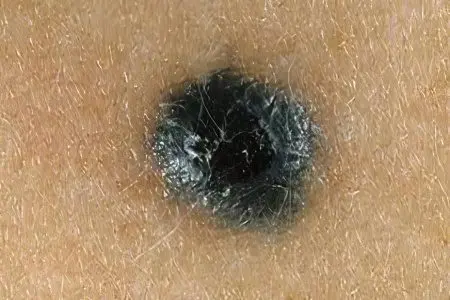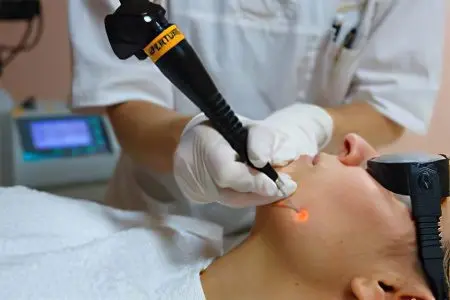Contents
blue nevus – This is a small skin formation that has a blue or dark blue color. The original color is associated with an increased concentration of melanin-producing cells in the dermis. Mostly found in a single form, but multiple “moles” are also possible. The good quality of the nevus does not prevent it from being dangerous, since the threat of developing melanoma is present.
Causes of the blue nevus

The laying of birthmarks occurs in the prenatal phase, so the following reasons for the appearance of a “blue mole” can be distinguished:
deviation in the development of the fetus;
damage to the genitourinary system by a pregnant infection;
hormonal surges associated with pregnancy;
harmful factors (radiation, toxic substances).
The result may be improper development, localization of melanoblasts, their accumulation, the appearance of a blue nevus.
The following factors can lead to an increase in the “mole”:
constant use of hormonal contraceptives;
physiological restructuring (pregnancy, feeding, adolescence);
skin diseases (inflammatory, allergic nature);
ultraviolet irradiation (prolonged exposure to the sun during dangerous hours, tanning in a solarium).
Types of formations
The form of the blue nevus is cellular, simple and combined:
A simple form has the appearance of accumulated cells saturated with melanin. A single nodule, protruding above the skin, is small, does not exceed a centimeter. The hue can vary from dark blue to light gray, the smoothness of the surface is characteristic. The most popular place is the neck, a nevus may appear on the hands and face.
The cellular form is represented by an accumulation of large cells, less filled with pigment. The diameter of the formation is larger, it can reach 3 cm. Uneven dark tones, lack of brightness are typical. The surface is rough. The main lesions are the hands, feet, buttocks, lower back.
The combined form is the result of combining a blue nevus with its other varieties (for example, with intradermal). The appearance resembles a knot, there is an interweaving of brown and blue tones. This type is characterized by surface heterogeneity, blurry edges. The affected places are the lumbar area, neck, palms.
Blue nevus treatment

Removal of the affected area is carried out with significant growth, alarming changes indicating malignant degeneration. The blue nevus does not cause any particular discomfort if it is not located in open areas of the body. If the formation behaves “calmly”, the patient is recommended only regular visits to the dermatologist and careful handling of the affected area, the exclusion of injury.
At the moment, the following options for its removal are available to owners of a blue nevus:
surgical excision;
radio wave method;
laser removal;
cryodestruction (exposure to liquid nitrogen);
electrocoagulation (use of high-frequency electric current).
Each technique is characterized by pluses and minuses, it is desirable to choose the best option with a doctor. The prevalence of the lesion, individual characteristics matter.
Surgical excision
Doctors turn to a radical technique if it is not possible to distinguish a blue nevus from melanoma, its changes are observed.
Symptoms of the beginning of rebirth:
the occurrence of tingling, itching, pain;
rapid growth;
coloring the mole in blue, black, increasing the intensity of the tone;
the occurrence of peeling;
surface transformation (appearance of hair, unevenness);
bleeding, soaking;
change in shape, loss of clarity of contours.
The nevus is excised with subcutaneous tissue, intact areas are captured (the indent is about 5-8 cm). If a blue mole is located on the face, the area of uXNUMXbuXNUMXbdamage to healthy skin is reduced. The final stage of the operation necessarily becomes a histological analysis.
Obviously, the cosmetic effect obtained as a result of surgical excision leaves much to be desired. Scars and scars will not appear if the patient turns to more modern techniques (which do not help in all cases).
Removal with liquid nitrogen
Cryodestruction is a procedure that is relevant for the fight against a simple blue nevus of a non-malignant nature. If the “mole” deeply affects the skin, a special apparatus is used – a cryodestructor. For superficial formations, treatment with liquid nitrogen using a cotton swab is sufficient.
Anesthesia is not required, as the manipulation is absolutely painless. The duration of the procedure does not exceed 3 minutes.
Much more time is spent on recovery, which proceeds as follows:
Hardening, discoloration, loss of sensation. Unpleasant sensations such as burning sensation are also possible.
Inflammatory reaction associated with the death of many cells, the formation of a crust.
Formation of new skin (begins around the second week).
Completion of the process, the formation of a full-fledged skin (4-6 weeks on average).
There is a possibility that one procedure will not be enough to completely get rid of the blue nevus.
Laser removal

The laser is currently recognized as the most effective tool for removing blue nevus. The accuracy of the laser beam penetration is guaranteed by a small diameter, a clear depth of impact. It is the laser that is recommended to combat skin formations that appear on the face, due to the excellent cosmetic result.
The presence/absence of traces depends on the extent of the lesion. Removal of deep formations can lead to the preservation of a colorless spot (for some people it disappears over time). “Moles” of compact size are eliminated without consequences. You can not be afraid of scarring, infection. The crust remaining on the area subjected to the operation performs a protective function.
Laser removal and cryosurgery can be chosen if there is no need for histological examination. Otherwise, it is better to stop at radio wave exposure or electrocoagulation.
Radioknife removal
Radioknife is a highly effective tool for getting rid of a blue nevus. The device is able to simultaneously remove the affected area, disinfect the wound and stop bleeding. You can not be afraid of scars, healthy areas of the skin will also not be affected.
Electrocoagulation
This procedure is not recommended for the removal of blue nevus, concentrating on open areas of the body, face. There is a possibility of small scarring. Treatment of the affected areas is carried out by means of high-frequency current. Healthy areas remain intact, bleeding does not occur.
All of the above procedures are available to children from the age of two. People who do not need immediate removal of the blue nevus should pay maximum attention to prevention. The most important measures are limiting the time spent under the sun (refusal of the solarium), careful handling of the formation, excluding injury.









